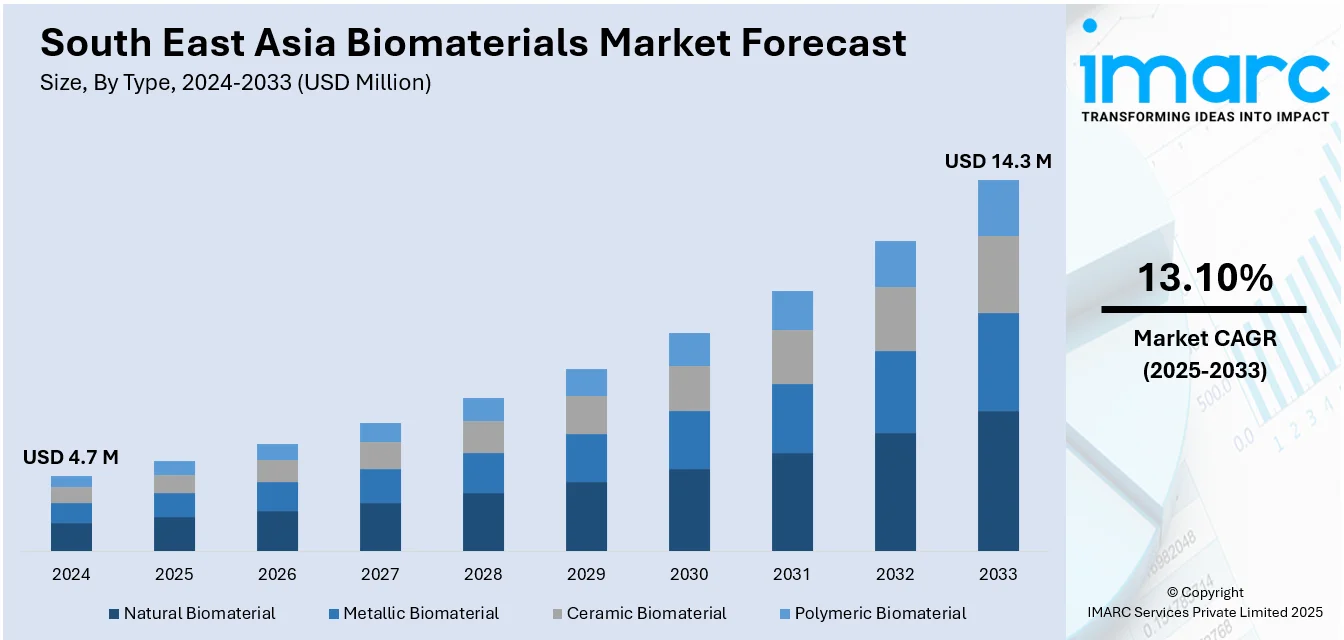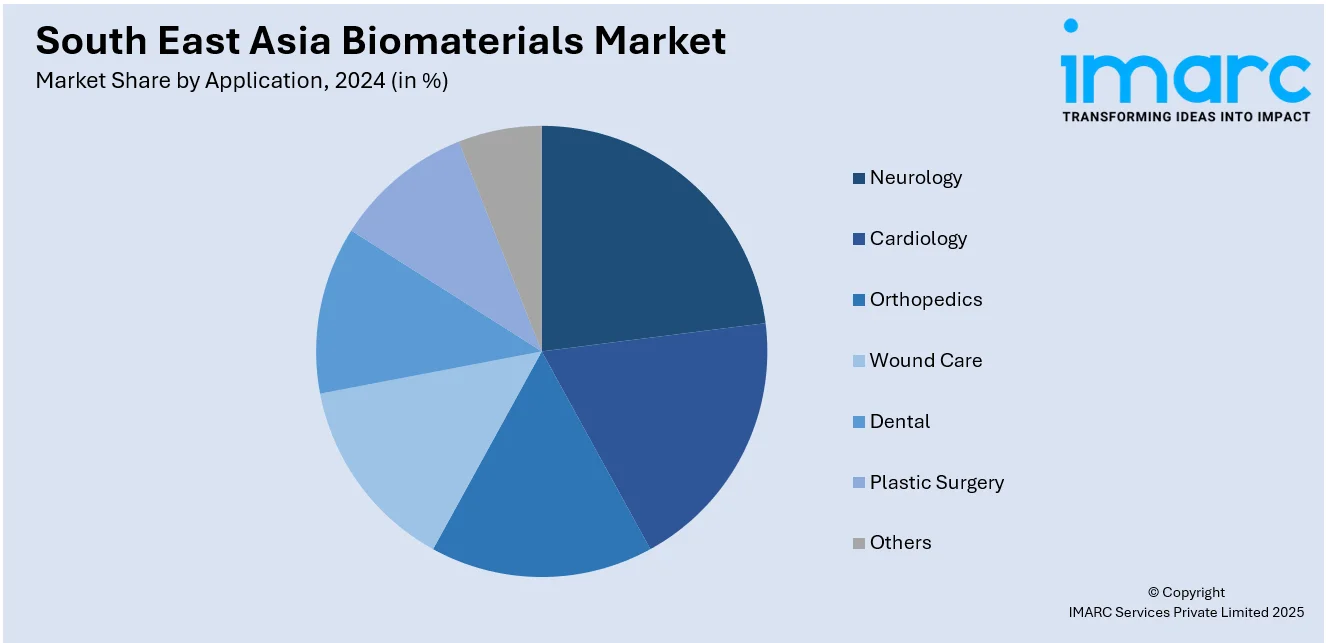
South East Asia Biomaterials Market Size, Share, Trends and Forecast by Type, Application, and Country, 2025-2033
Market Overview:
South East Asia biomaterials market size reached USD 4.7 Million in 2024. Looking forward, IMARC Group expects the market to reach USD 14.3 Million by 2033, exhibiting a growth rate (CAGR) of 13.10% during 2025-2033. The widespread utilization of biomaterials in advanced medical treatments, recent technological advancements, growing awareness and acceptance of advanced medical procedures, rising healthcare expenditure in the region, and increasing investment in research and innovation activities represent some of the key factors driving the market.
|
Report Attribute
|
Key Statistics
|
|---|---|
|
Base Year
|
2024
|
|
Forecast Years
|
2025-2033
|
|
Historical Years
|
2019-2024
|
|
Market Size in 2024
|
USD 4.7 Million |
|
Market Forecast in 2033
|
USD 14.3 Million |
| Market Growth Rate 2025-2033 | 13.10% |
Biomaterials refer to substances engineered to interact with biological systems for medical purposes, such as therapeutic or diagnostic. They encompass a range of substances, including titanium, stainless steel, biodegradable polymers, and bioactive glasses. Biomaterials exhibit distinct properties, such as biocompatibility, non-toxicity, and natural healing capabilities. Their manufacturing processes vary based on the end application, such as molding, three-dimensional (3D) printing, and nano-technology-based methods. Biomaterials are widely used in orthopedics, cardiovascular systems, ophthalmology, dental applications, skin repair, wound healing, drug delivery systems, prosthetics, diagnostic devices, and tissue engineering. They aid in improving patient outcomes, reducing recovery time, ensuring compatibility with human tissues, minimizing infection risks, enhancing the durability of implants, and providing controlled drug release. In addition, biomaterials offer several advantages, such as promotion of natural healing processes, reduction of healthcare costs, and adaptability to various medical applications.

To get more information on this market, Request Sample
South East Asia Biomaterials Market Trends:
The widespread utilization of biomaterials in advanced medical treatments for chronic diseases is propelling the market growth. Additionally, recent technological advancements in biomaterials, leading to the development of more efficient and cost-effective solutions, are catalyzing the market growth. Besides this, the growing awareness and acceptance of advanced medical procedures among the population, is contributing to the market growth. Furthermore, the rising healthcare expenditures in the region, which support the adoption of sophisticated biomaterials, are boosting the market growth. In addition, the increasing investment in research and innovation activities in the healthcare sector, which is driving innovation in biomaterials, that is propelling\ the market growth. Apart from this, the presence of several key players in the region, along with their strategic initiatives, is fostering the market growth. Moreover, the rising demand for biomaterials due to their biocompatibility and reduced environmental impact is acting as another growth-inducing factor. Along with this, the emerging trends of personalized medicines, leading to more customized biomaterial solutions, are bolstering the market growth. Additionally, the introduction of various government policies and funding in healthcare are positively impacting the market growth. Furthermore, the growing emphasis on regenerative medicine and tissue engineering, which require advanced biomaterials, is accelerating the market growth. Besides this, the rising prevalence of lifestyle-related diseases, such as diabetes and cardiovascular disorders, necessitating long-term treatment modalities, where biomaterials are crucial, is stimulating the market growth. In addition to this, the increasing foreign direct investment (FDI) in the healthcare sector of South East Asian countries is favoring the market growth. Apart from this, the rising collaborations between academic institutions and industry for biomaterials research that are accelerating new product development are strengthening the market growth.
South East Asia Biomaterials Market Segmentation:
IMARC Group provides an analysis of the key trends in each segment of the market, along with forecasts at the regional and country level for 2025-2033. Our report has categorized the market based on type and application.
Type Insights:
- Natural Biomaterial
- Metallic Biomaterial
- Ceramic Biomaterial
- Polymeric Biomaterial
The report has provided a detailed breakup and analysis of the market based on the type. This includes natural biomaterial, metallic biomaterial, ceramic biomaterial, and polymeric biomaterial.
Application Insights:

- Neurology
- Cardiology
- Orthopedics
- Wound Care
- Dental
- Plastic Surgery
- Others
A detailed breakup and analysis of the market based on the application have also been provided in the report. This includes neurology, cardiology, orthopedics, wound care, dental, plastic surgery, and others.
Country Insights:
- Indonesia
- Thailand
- Singapore
- Philippines
- Vietnam
- Malaysia
- Others
The report has also provided a comprehensive analysis of all the major regional markets, which include Indonesia, Thailand, Singapore, Philippines, Vietnam, Malaysia, and Others.
Competitive Landscape:
The market research report has also provided a comprehensive analysis of the competitive landscape in the market. Competitive analysis such as market structure, key player positioning, top winning strategies, competitive dashboard, and company evaluation quadrant has been covered in the report. Also, detailed profiles of all major companies have been provided.
South East Asia Biomaterials Market Report Coverage:
| Report Features | Details |
|---|---|
| Base Year of the Analysis | 2024 |
| Historical Period | 2019-2024 |
| Forecast Period | 2025-2033 |
| Units | Million USD |
| Scope of the Report | Exploration of Historical Trends and Market Outlook, Industry Catalysts and Challenges, Segment-Wise Historical and Future Market Assessment:
|
| Types Covered | Natural Biomaterial, Metallic Biomaterial, Ceramic Biomaterial, Polymeric Biomaterial |
| Applications Covered | Neurology, Cardiology, Orthopedics, Wound Care, Dental, Plastic Surgery, Others |
| Countries Covered | Indonesia, Thailand, Singapore, Philippines, Vietnam, Malaysia, Others |
| Customization Scope | 10% Free Customization |
| Post-Sale Analyst Support | 10-12 Weeks |
| Delivery Format | PDF and Excel through Email (We can also provide the editable version of the report in PPT/Word format on special request) |
Key Questions Answered in This Report:
- How has the South East Asia biomaterials market performed so far and how will it perform in the coming years?
- What is the breakup of the South East Asia biomaterials market on the basis of type?
- What is the breakup of the South East Asia biomaterials market on the basis of application?
- What are the various stages in the value chain of the South East Asia biomaterials market?
- What are the key driving factors and challenges in the South East Asia biomaterials?
- What is the structure of the South East Asia biomaterials market and who are the key players?
- What is the degree of competition in the South East Asia biomaterials market?
Key Benefits for Stakeholders:
- IMARC’s industry report offers a comprehensive quantitative analysis of various market segments, historical and current market trends, market forecasts, and dynamics of the South East Asia biomaterials market from 2019-2033.
- The research report provides the latest information on the market drivers, challenges, and opportunities in the South East Asia biomaterials market.
- Porter's five forces analysis assist stakeholders in assessing the impact of new entrants, competitive rivalry, supplier power, buyer power, and the threat of substitution. It helps stakeholders to analyze the level of competition within the South East Asia biomaterials industry and its attractiveness.
- Competitive landscape allows stakeholders to understand their competitive environment and provides an insight into the current positions of key players in the market.
Need more help?
- Speak to our experienced analysts for insights on the current market scenarios.
- Include additional segments and countries to customize the report as per your requirement.
- Gain an unparalleled competitive advantage in your domain by understanding how to utilize the report and positively impacting your operations and revenue.
- For further assistance, please connect with our analysts.
 Request Customization
Request Customization
 Speak to an Analyst
Speak to an Analyst
 Request Brochure
Request Brochure
 Inquire Before Buying
Inquire Before Buying




.webp)




.webp)












